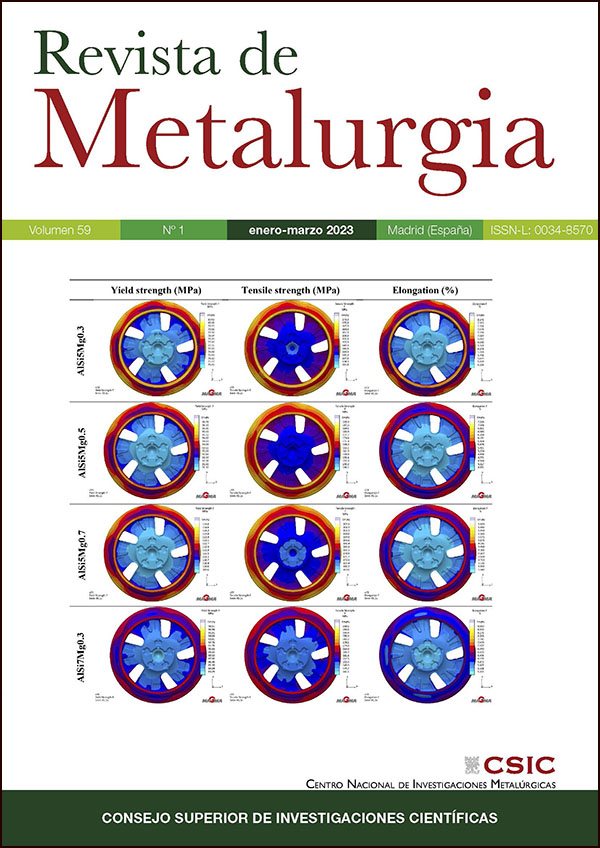Experimental-numerical analysis to determine the efficiency of industrial lubricants in wire drawing process
DOI:
https://doi.org/10.3989/revmetalm.234Keywords:
Drawing, Efficiency, FEM analysis, Friction, Cold formingAbstract
Drawing is a manufacturing process that consists of indirect deformation by pulling the material through a tool with a conical geometry. The process is usually performed at room temperature (cold forming), so the selection of effective lubricants is critical. If lubrication is inadequate, there is a high risk that both, tool and the manufactured wire, will fail. In this study, annealed AISI 1020 steel rods were drawn and the effectiveness of three different industrial lubricants was tested. During the process, the drawing force values were recorded and used to determine the friction coefficient that developed under each lubrication condition. Numerical simulations were performed to further understand the process. Based on the experimental and numerical results, qualitative and quantitative analysis were performed for each condition. Among the different lubricants used in this study, zinc stearate showed the lowest value for drawing force, 18.8 kN, followed by Lub A and B with values of 20 kN and 20.6 kN, respectively. The numerical models showed excellent approximation to the force values determined in the tests. The values for the coefficient of friction obtained by both the numerical analysis and the empirical model indicate that zinc stearate has the highest lubricating effect among the lubricants focused on this study.
Downloads
References
Ajiboye, J.S., Jung, K.H., Im, Y.T. (2010). Sensitivity study of frictional behavior by dimensional analysis in cold forging. J. Mech. Sci. Technol. 24, 115-118. https://doi.org/10.1007/s12206-009-1202-x
Alba, D.R., Santos, T.G., Schaeffer, L. (2018). Otimização em elementos finitos para definição do fator de atrito através de ensaios de compressão de anéis. 22nd International Forging Conference, 38 SENAFOR, Brazil.
ASM Handbook (2004). Metallography and Microstructure. Volume 9, ASM International, Materials Park, George F. Vander Voort (Editor), OH, USA.
ASTM E8 (2013). Tensile Testing of Metals. ASTM International, West Conshohocken, PA, USA.
Bresciani, F.E., Zavaglia, C.A.C., Nery, F.A.C., Button, S.T. (1986). Conformação Plástica dos Metais. V.2, Editora Unicamp.
De Castro, A.L.R., Campos, H.B., Cetlin, P.R. (1996). Influence of die semi-angle on mechanical properties of single and multiple pass drawn copper. J. Mater. Process. Technol. 60 (1-4), 179-182. https://doi.org/10.1016/0924-0136(96)02325-4
Dieter, G.E. (1981). Metalurgia Mecânica. 2ª Edição, Editora Guanabara.
Dixit, U.S., Dixit, P.M. (1995). An analysis of the steady-state wire drawing of strain-hardening materials. J. Mater. Process. Technol. 47 (3-4), 201-229. https://doi.org/10.1016/0924-0136(95)85000-7
Hollomon, J.H. (1945). Tensile deformation. Trans. Metall. Soc. AIME, 162, 268-290.
Moon, C., Kim, N. (2012). Analysis of wire-drawing process with friction and thermal conditions obtained by inverse engineering. J. Mech. Sci. Technol. 26 (9), 2903-2911. https://doi.org/10.1007/s12206-012-0711-1
Norasethasopon, S., Yoshida, K. (2006). Influences of inclusion shape and size in drawing of copper shaped-wire. J. Mater. Process. Technol. 172 (3), 400-406. https://doi.org/10.1016/j.jmatprotec.2005.09.020
Överstam, H. (2006). The influence of bearing geometry on the residual stress state in cold drawn wire, analyzed by the FEM. J. Mater. Process. Technol. 171 (3), 446-450. https://doi.org/10.1016/j.jmatprotec.2005.08.012
Platov, S.I., Nekit, V.A., Ogarkov, N.N. (2017). Determination of Frictional Forces during Wire Rod Drawing Process by Reverse Method. Solid State Phenom. 265, 1152-1156. https://doi.org/10.4028/www.scientific.net/SSP.265.1152
Santos, T.G., Alba, D.R., Schaeffer, L. (2019). Análise do desempenho de diferentes modelos de atrito na simulação numérica do processo de forjamento isotérmico. 23nd International Forging Conference, 39 SENAFOR, Brazil.
Schaeffer, L. (2004). Conformação Mecânica. 2ª edição, Imprensa Livre Editora, Porto Alegre.
Siebel, E. (1947). Der decretage Stand der Erkenntnisse über Die Mechanischen beim Drahtziehen. Stahl und Eisen 11-12, 171-204. https://delibra.bg.polsl.pl/Content/48253/BCPS_52703_1947_Stahl-und-Eisen--Jg-.pdf
Vega, G., Haddi, A., Imad, A. (2009). Temperature effects on wire drawing process: experimental investigation. Int. J. Mater. Form. 2 (Suppl. 1), 229-232. https://doi.org/10.1007/s12289-009-0468-y
Wistreich, J.G. (1955). Investigation of the Mechanics of Wire Drawing. Proc. Inst. Mech. Eng. 169 (1), 654-678. https://doi.org/10.1243/PIME_PROC_1955_169_070_02
Published
How to Cite
Issue
Section
License
Copyright (c) 2023 Consejo Superior de Investigaciones Científicas (CSIC)

This work is licensed under a Creative Commons Attribution 4.0 International License.
© CSIC. Manuscripts published in both the printed and online versions of this Journal are the property of Consejo Superior de Investigaciones Científicas, and quoting this source is a requirement for any partial or full reproduction.
All contents of this electronic edition, except where otherwise noted, are distributed under a “Creative Commons Attribution 4.0 International” (CC BY 4.0) License. You may read the basic information and the legal text of the license. The indication of the CC BY 4.0 License must be expressly stated in this way when necessary.
Self-archiving in repositories, personal webpages or similar, of any version other than the published by the Editor, is not allowed.
Funding data
Conselho Nacional de Desenvolvimento Científico e Tecnológico
Grant numbers 18/2021;404196/2021-7;PQ1-4/2021;PDJ-25/2021;GD-2019
Coordenação de Aperfeiçoamento de Pessoal de Nível Superior
Grant numbers PROEX-IES-2020
















